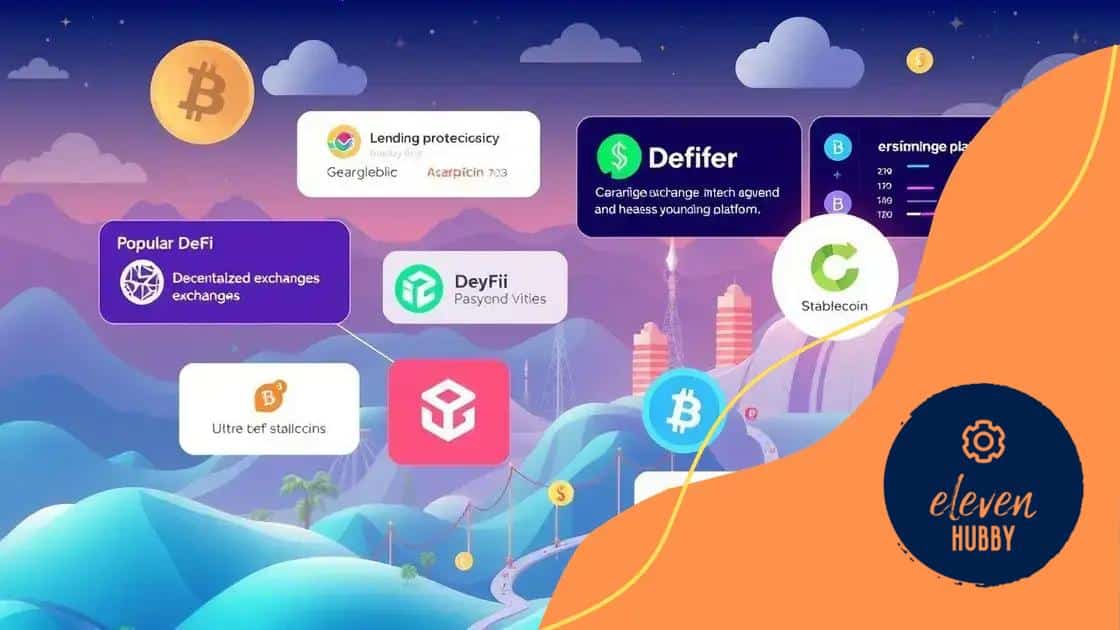The evolution of decentralized finance (DeFi) platforms

The evolution of decentralized finance (DeFi) platforms is transforming the financial landscape by offering increased accessibility, lower fees, enhanced security, and innovative financial services without traditional intermediaries.
The evolution of decentralized finance (DeFi) platforms is transforming how we think about money and financial services. You might be wondering: how does this shift affect your daily financial decisions? Let’s dive into the details.
Understanding decentralized finance (DeFi)
Understanding decentralized finance (DeFi) is crucial for anyone looking to navigate today’s financial landscape. DeFi offers a fresh approach to money management, enabling users to access services without relying on traditional banks.
At its core, DeFi leverages blockchain technology to provide financial services, which means transactions are transparent, secure, and immutable. This technology empowers individuals with more control over their financial assets.
What makes DeFi unique?
Unlike conventional finance, where intermediaries play a significant role, DeFi eliminates them, leading to several advantages.
- Increased accessibility for everyone.
- Lower fees compared to traditional financial systems.
- Improved security through smart contracts.
- Greater transparency because of open-source protocols.
Moreover, DeFi platforms are often built on open standards, allowing anyone to develop and contribute. This open ecosystem promotes innovation, enabling rapid changes and improvements.
Another exciting aspect is the wide variety of services available. Users can engage in lending, borrowing, trading, and earning interest—all without intermediaries. This democratization of finance allows for efficient asset management.
Risks inherent in DeFi
While the benefits are substantial, risks also abound in the DeFi space. It’s essential to understand these challenges to navigate the ecosystem safely.
- Smart contract vulnerabilities can lead to losses.
- Market volatility can impact asset value significantly.
- The potential for regulatory changes affecting platforms.
As you delve deeper into DeFi, recognizing these risks will help you make informed decisions and maximize your benefits.
In summary, understanding decentralized finance means recognizing its potential to transform how we interact with money. Embracing this innovative technology opens doors to countless opportunities in the financial realm.
Key advantages of DeFi platforms
Decentralized finance (DeFi) platforms offer a range of advantages that set them apart from traditional financial systems. These benefits not only enhance user experience but also empower individuals with greater control over their finances.
One of the foremost advantages is accessibility. DeFi protocols can be accessed by anyone with an internet connection. This eliminates barriers faced by individuals in underbanked regions who may not have access to conventional banking services.
Benefits of using DeFi platforms
Another significant aspect of DeFi is the reduction in costs. By cutting out intermediaries, users can enjoy lower fees for transactions and services.
- Transaction fees are often minimal or even nonexistent.
- Users can earn higher interest rates on deposits.
- Lending and borrowing markets allow for competitive rates.
- Smart contracts automate processes, reducing administrative costs.
Moreover, transparency is a critical benefit of DeFi. All transactions on the blockchain are publicly recorded and verifiable, allowing users to verify the integrity of the platform and its operations.
Furthermore, DeFi fosters innovation. With many platforms being open-source, developers continuously create new applications, enhancing the functionality and user experience. This encourages community participation and engagement, driving the ecosystem forward.
Enhanced security measures
Security is another advantage that comes with DeFi platforms. Utilizing blockchain technology ensures that assets are protected from fraud and hacking. The decentralized nature of these platforms also reduces the risks associated with centralized data storage.
In conclusion, the advantages of DeFi platforms create a low-cost, accessible, and secure environment for users. By leveraging technology and community-driven innovation, decentralized finance is paving the way for a new financial future.
Popular DeFi platforms currently

When exploring decentralized finance (DeFi), understanding the popular platforms is essential. These platforms offer unique services and address different financial needs.
One of the leading DeFi platforms is Uniswap. It is a decentralized exchange that allows users to trade cryptocurrencies without the need for intermediaries. Its automated liquidity protocol enables users to swap tokens easily.
Top DeFi platforms
Another well-known platform is Aave. Aave allows users to lend and borrow assets in a decentralized manner. With its unique features, like flash loans, users can access instant credit without needing collateral upfront.
- Users can earn interest on deposited assets.
- Flash loans provide instant liquidity.
- Multiple cryptocurrencies are supported.
Compound is also popular in the DeFi space. It operates as a money market where users can earn interest on their deposits. By lending their assets, users contribute to the platform’s liquidity.
As users deposit and borrow assets, they have the opportunity to earn rewards and benefit from competitive interest rates. This ecosystem promotes earning potential while maintaining control over their funds.
Emerging platforms to watch
Moreover, Curve Finance specializes in stablecoin trading. It offers low slippage and efficient swaps between similar assets, making it popular among users focused on stablecoins.
- Highly efficient stablecoin exchanges.
- Low fees and quick transactions.
- Allows liquidity provision for stable assets.
It’s not just the established platforms that matter. New entrants like Yearn Finance are also gaining traction. Yearn automates yield farming, allowing users to maximize returns on their crypto investments effortlessly.
Understanding these popular DeFi platforms can empower users to make informed decisions and choose the best options for their financial practices.
Challenges facing DeFi today
Despite the growth of decentralized finance (DeFi), several challenges impact its development. Recognizing these challenges is essential for users and developers alike.
One significant issue is security risks. DeFi platforms are often the targets of hacks and scams. Vulnerabilities in smart contracts can lead to substantial financial losses for users.
Major challenges in DeFi
Another challenge is the lack of regulation. Since DeFi operates outside traditional financial systems, issues like fraud, money laundering, and regulatory compliance pose risks. Users must navigate this uncertain landscape cautiously.
- Potential regulatory actions could affect platform operations.
- Users often have little recourse if something goes wrong.
- Transparency issues may still exist in some projects.
Additionally, the complexity of DeFi platforms can be a barrier for new users. Understanding how to use these services often requires technical knowledge, which can discourage adoption.
Moreover, market volatility can lead to significant risks. Prices of cryptocurrencies can fluctuate dramatically, affecting the value of assets held in DeFi platforms. Users may face unexpected loses due to sudden market changes.
Adoption and scalability issues
Furthermore, DeFi platforms face scalability challenges.
- High transaction fees on certain networks can limit usability.
- Network congestion may slow down transactions.
- Not all platforms can handle increased user activity effectively.
In summary, while DeFi offers great opportunities, it is essential to acknowledge the challenges it faces. By understanding these issues, users can make informed decisions and navigate the evolving DeFi landscape effectively.
The future of decentralized finance
The future of decentralized finance (DeFi) looks promising and exciting. With rapid advancements in technology, DeFi platforms are set to evolve in ways that can transform the financial landscape.
One possible trend is the increasing adoption of DeFi applications across various sectors. More individuals and businesses are beginning to understand the benefits of decentralized finance, which can lead to wider user bases and greater liquidity in the markets.
Innovations on the horizon
Additionally, integration with traditional financial systems may occur. As banks and financial institutions recognize the value of DeFi, they could incorporate these technologies into their services, creating a hybrid financial system that offers both stability and innovation.
- Potential partnerships between DeFi platforms and traditional banks.
- Enhanced user experience through combined services.
- Access to broader markets for decentralized projects.
Another exciting aspect of the future involves enhanced security measures. As the DeFi ecosystem matures, developers are likely to focus on creating more robust security protocols to protect users from risks and vulnerabilities.
Moreover, usability improvements are expected. As platforms become more user-friendly, even those without technical backgrounds will find it easier to navigate and utilize DeFi services. This accessibility will encourage greater participation in the DeFi ecosystem.
Regulatory developments
Furthermore, the regulatory environment may change. Governments around the world are starting to pay attention to DeFi, which could result in new regulations aimed at protecting users while fostering innovation.
- Regulations may provide clearer guidelines for operations.
- Compliance could build trust among users.
- Potential for safer investment opportunities.
Overall, the future of decentralized finance is bright, with numerous advancements on the horizon. The potential to reshape financial systems presents exciting opportunities for everyone involved.
Conclusion: The decentralized finance (DeFi) landscape is rapidly evolving, offering many opportunities and challenges. As more people explore DeFi platforms, understanding their benefits and risks becomes increasingly important. The future looks bright, with innovations that can enhance security, usability, and regulatory clarity. By staying informed, users can navigate DeFi more effectively and unlock its full potential.
FAQ – Frequently Asked Questions about Decentralized Finance (DeFi)
What is decentralized finance (DeFi)?
DeFi refers to a financial system built on blockchain technology, allowing users to access financial services without traditional intermediaries like banks.
What are the main advantages of using DeFi platforms?
DeFi platforms offer advantages such as lower fees, increased accessibility, enhanced security through smart contracts, and the ability to earn higher interest rates on deposits.
What challenges does DeFi face today?
Current challenges include security risks, lack of regulation, usability barriers for new users, and market volatility that can impact asset values.
How can I get started with DeFi?
You can start by researching popular DeFi platforms, setting up a cryptocurrency wallet, and understanding the risks and benefits associated with decentralized finance.






